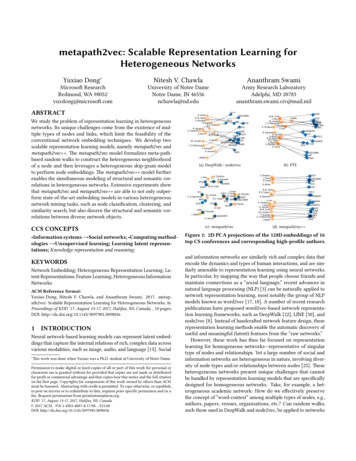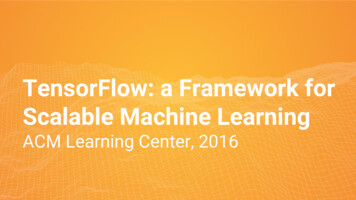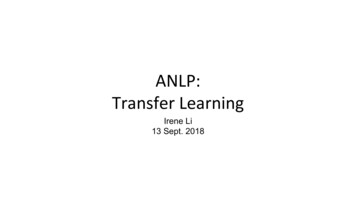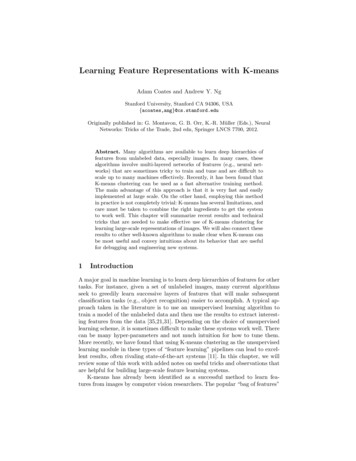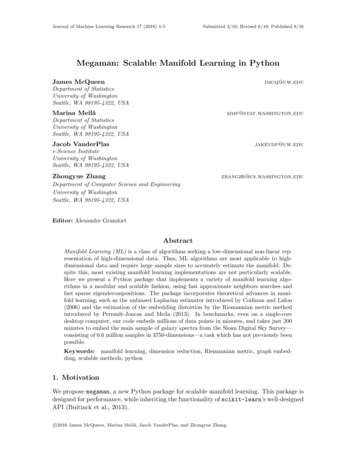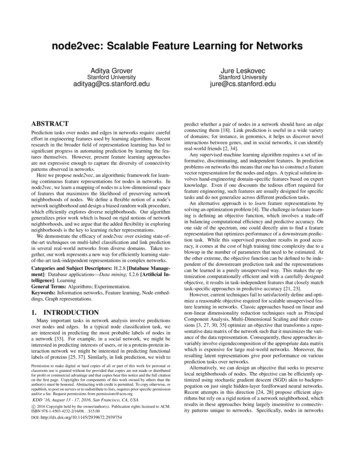
Transcription
node2vec: Scalable Feature Learning for NetworksAditya GroverStanford n tasks over nodes and edges in networks require carefuleffort in engineering features used by learning algorithms. Recentresearch in the broader field of representation learning has led tosignificant progress in automating prediction by learning the features themselves. However, present feature learning approachesare not expressive enough to capture the diversity of connectivitypatterns observed in networks.Here we propose node2vec, an algorithmic framework for learning continuous feature representations for nodes in networks. Innode2vec, we learn a mapping of nodes to a low-dimensional spaceof features that maximizes the likelihood of preserving networkneighborhoods of nodes. We define a flexible notion of a node’snetwork neighborhood and design a biased random walk procedure,which efficiently explores diverse neighborhoods. Our algorithmgeneralizes prior work which is based on rigid notions of networkneighborhoods, and we argue that the added flexibility in exploringneighborhoods is the key to learning richer representations.We demonstrate the efficacy of node2vec over existing state-ofthe-art techniques on multi-label classification and link predictionin several real-world networks from diverse domains. Taken together, our work represents a new way for efficiently learning stateof-the-art task-independent representations in complex networks.Categories and Subject Descriptors: H.2.8 [Database Management]: Database applications—Data mining; I.2.6 [Artificial Intelligence]: LearningGeneral Terms: Algorithms; Experimentation.Keywords: Information networks, Feature learning, Node embeddings, Graph representations.1.INTRODUCTIONMany important tasks in network analysis involve predictionsover nodes and edges. In a typical node classification task, weare interested in predicting the most probable labels of nodes ina network [33]. For example, in a social network, we might beinterested in predicting interests of users, or in a protein-protein interaction network we might be interested in predicting functionallabels of proteins [25, 37]. Similarly, in link prediction, we wish toPermission to make digital or hard copies of all or part of this work for personal orclassroom use is granted without fee provided that copies are not made or distributedfor profit or commercial advantage and that copies bear this notice and the full citationon the first page. Copyrights for components of this work owned by others than theauthor(s) must be honored. Abstracting with credit is permitted. To copy otherwise, orrepublish, to post on servers or to redistribute to lists, requires prior specific permissionand/or a fee. Request permissions from permissions@acm.org.KDD ’16, August 13 - 17, 2016, San Francisco, CA, USAc 2016 Copyright held by the owner/author(s). Publication rights licensed to ACM.ISBN 978-1-4503-4232-2/16/08. . . 15.00DOI: http://dx.doi.org/10.1145/2939672.2939754Jure LeskovecStanford Universityjure@cs.stanford.edupredict whether a pair of nodes in a network should have an edgeconnecting them [18]. Link prediction is useful in a wide varietyof domains; for instance, in genomics, it helps us discover novelinteractions between genes, and in social networks, it can identifyreal-world friends [2, 34].Any supervised machine learning algorithm requires a set of informative, discriminating, and independent features. In predictionproblems on networks this means that one has to construct a featurevector representation for the nodes and edges. A typical solution involves hand-engineering domain-specific features based on expertknowledge. Even if one discounts the tedious effort required forfeature engineering, such features are usually designed for specifictasks and do not generalize across different prediction tasks.An alternative approach is to learn feature representations bysolving an optimization problem [4]. The challenge in feature learning is defining an objective function, which involves a trade-offin balancing computational efficiency and predictive accuracy. Onone side of the spectrum, one could directly aim to find a featurerepresentation that optimizes performance of a downstream prediction task. While this supervised procedure results in good accuracy, it comes at the cost of high training time complexity due to ablowup in the number of parameters that need to be estimated. Atthe other extreme, the objective function can be defined to be independent of the downstream prediction task and the representationscan be learned in a purely unsupervised way. This makes the optimization computationally efficient and with a carefully designedobjective, it results in task-independent features that closely matchtask-specific approaches in predictive accuracy [21, 23].However, current techniques fail to satisfactorily define and optimize a reasonable objective required for scalable unsupervised feature learning in networks. Classic approaches based on linear andnon-linear dimensionality reduction techniques such as PrincipalComponent Analysis, Multi-Dimensional Scaling and their extensions [3, 27, 30, 35] optimize an objective that transforms a representative data matrix of the network such that it maximizes the variance of the data representation. Consequently, these approaches invariably involve eigendecomposition of the appropriate data matrixwhich is expensive for large real-world networks. Moreover, theresulting latent representations give poor performance on variousprediction tasks over networks.Alternatively, we can design an objective that seeks to preservelocal neighborhoods of nodes. The objective can be efficiently optimized using stochastic gradient descent (SGD) akin to backpropogation on just single hidden-layer feedforward neural networks.Recent attempts in this direction [24, 28] propose efficient algorithms but rely on a rigid notion of a network neighborhood, whichresults in these approaches being largely insensitive to connectivity patterns unique to networks. Specifically, nodes in networks
could be organized based on communities they belong to (i.e., homophily); in other cases, the organization could be based on thestructural roles of nodes in the network (i.e., structural equivalence) [7, 10, 36]. For instance, in Figure 1, we observe nodesu and s1 belonging to the same tightly knit community of nodes,while the nodes u and s6 in the two distinct communities share thesame structural role of a hub node. Real-world networks commonlyexhibit a mixture of such equivalences. Thus, it is essential to allowfor a flexible algorithm that can learn node representations obeyingboth principles: ability to learn representations that embed nodesfrom the same network community closely together, as well as tolearn representations where nodes that share similar roles have similar embeddings. This would allow feature learning algorithms togeneralize across a wide variety of domains and prediction tasks.Present work. We propose node2vec, a semi-supervised algorithmfor scalable feature learning in networks. We optimize a customgraph-based objective function using SGD motivated by prior workon natural language processing [21]. Intuitively, our approach returns feature representations that maximize the likelihood of preserving network neighborhoods of nodes in a d-dimensional feature space. We use a 2nd order random walk approach to generate(sample) network neighborhoods for nodes.Our key contribution is in defining a flexible notion of a node’snetwork neighborhood. By choosing an appropriate notion of aneighborhood, node2vec can learn representations that organizenodes based on their network roles and/or communities they belong to. We achieve this by developing a family of biased randomwalks, which efficiently explore diverse neighborhoods of a givennode. The resulting algorithm is flexible, giving us control over thesearch space through tunable parameters, in contrast to rigid searchprocedures in prior work [24, 28]. Consequently, our method generalizes prior work and can model the full spectrum of equivalencesobserved in networks. The parameters governing our search strategy have an intuitive interpretation and bias the walk towards different network exploration strategies. These parameters can alsobe learned directly using a tiny fraction of labeled data in a semisupervised fashion.We also show how feature representations of individual nodescan be extended to pairs of nodes (i.e., edges). In order to generatefeature representations of edges, we compose the learned featurerepresentations of the individual nodes using simple binary operators. This compositionality lends node2vec to prediction tasksinvolving nodes as well as edges.Our experiments focus on two common prediction tasks in networks: a multi-label classification task, where every node is assigned one or more class labels and a link prediction task, where wepredict the existence of an edge given a pair of nodes. We contrastthe performance of node2vec with state-of-the-art feature learningalgorithms [24, 28]. We experiment with several real-world networks from diverse domains, such as social networks, informationnetworks, as well as networks from systems biology. Experimentsdemonstrate that node2vec outperforms state-of-the-art methods byup to 26.7% on multi-label classification and up to 12.6% on linkprediction. The algorithm shows competitive performance witheven 10% labeled data and is also robust to perturbations in theform of noisy or missing edges. Computationally, the major phasesof node2vec are trivially parallelizable, and it can scale to largenetworks with millions of nodes in a few hours.Overall our paper makes the following contributions:1. We propose node2vec, an efficient scalable algorithm forfeature learning in networks that efficiently optimizes a novelnetwork-aware, neighborhood preserving objective using SGD.2. We show how node2vec is in accordance with establisheds1s2us3s8s7s6s4s5s9BFSDFSFigure 1: BFS and DFS search strategies from node u (k 3).principles in network science, providing flexibility in discovering representations conforming to different equivalences.3. We extend node2vec and other feature learning methods basedon neighborhood preserving objectives, from nodes to pairsof nodes for edge-based prediction tasks.4. We empirically evaluate node2vec for multi-label classification and link prediction on several real-world datasets.The rest of the paper is structured as follows. In Section 2, webriefly survey related work in feature learning for networks. Wepresent the technical details for feature learning using node2vecin Section 3. In Section 4, we empirically evaluate node2vec onprediction tasks over nodes and edges on various real-world networks and assess the parameter sensitivity, perturbation analysis,and scalability aspects of our algorithm. We conclude with a discussion of the node2vec framework and highlight some promising directions for future work in Section 5. Datasets and a reference implementation of node2vec are available on the project page:http://snap.stanford.edu/node2vec.2.RELATED WORKFeature engineering has been extensively studied by the machinelearning community under various headings. In networks, the conventional paradigm for generating features for nodes is based onfeature extraction techniques which typically involve some seedhand-crafted features based on network properties [8, 11]. In contrast, our goal is to automate the whole process by casting featureextraction as a representation learning problem in which case wedo not require any hand-engineered features.Unsupervised feature learning approaches typically exploit thespectral properties of various matrix representations of graphs, especially the Laplacian and the adjacency matrices. Under this linearalgebra perspective, these methods can be viewed as dimensionality reduction techniques. Several linear (e.g., PCA) and non-linear(e.g., IsoMap) dimensionality reduction techniques have been proposed [3, 27, 30, 35]. These methods suffer from both computational and statistical performance drawbacks. In terms of computational efficiency, eigendecomposition of a data matrix is expensiveunless the solution quality is significantly compromised with approximations, and hence, these methods are hard to scale to largenetworks. Secondly, these methods optimize for objectives that arenot robust to the diverse patterns observed in networks (such as homophily and structural equivalence) and make assumptions aboutthe relationship between the underlying network structure and theprediction task. For instance, spectral clustering makes a stronghomophily assumption that graph cuts will be useful for classification [29]. Such assumptions are reasonable in many scenarios, butunsatisfactory in effectively generalizing across diverse networks.Recent advancements in representational learning for natural language processing opened new ways for feature learning of discreteobjects such as words. In particular, the Skip-gram model [21] aimsto learn continuous feature representations for words by optimizing a neighborhood preserving likelihood objective. The algorithm
proceeds as follows: It scans over the words of a document, andfor every word it aims to embed it such that the word’s featurescan predict nearby words (i.e., words inside some context window). The word feature representations are learned by optmizingthe likelihood objective using SGD with negative sampling [22].The Skip-gram objective is based on the distributional hypothesis which states that words in similar contexts tend to have similarmeanings [9]. That is, similar words tend to appear in similar wordneighborhoods.Inspired by the Skip-gram model, recent research establishedan analogy for networks by representing a network as a “document” [24, 28]. The same way as a document is an ordered sequence of words, one could sample sequences of nodes from theunderlying network and turn a network into a ordered sequence ofnodes. However, there are many possible sampling strategies fornodes, resulting in different learned feature representations. In fact,as we shall show, there is no clear winning sampling strategy thatworks across all networks and all prediction tasks. This is a majorshortcoming of prior work which fail to offer any flexibility in sampling of nodes from a network [24, 28]. Our algorithm node2vecovercomes this limitation by designing a flexible objective that isnot tied to a particular sampling strategy and provides parametersto tune the explored search space (see Section 3).Finally, for both node and edge based prediction tasks, there isa body of recent work for supervised feature learning based on existing and novel graph-specific deep network architectures [15, 16,17, 31, 39]. These architectures directly minimize the loss functionfor a downstream prediction task using several layers of non-lineartransformations which results in high accuracy, but at the cost ofscalability due to high training time requirements.3.FEATURE LEARNING FRAMEWORKWe formulate feature learning in networks as a maximum likelihood optimization problem. Let G (V, E) be a given network. Our analysis is general and applies to any (un)directed,(un)weighted network. Let f : V Rd be the mapping function from nodes to feature representaions we aim to learn for adownstream prediction task. Here d is a parameter specifying thenumber of dimensions of our feature representation. Equivalently,f is a matrix of size V d parameters. For every source nodeu V , we define NS (u) V as a network neighborhood of nodeu generated through a neighborhood sampling strategy S.We proceed by extending the Skip-gram architecture to networks[21, 24]. We seek to optimize the following objective function,which maximizes the log-probability of observing a network neighborhood NS (u) for a node u conditioned on its feature representation, given by f :Xmaxlog P r(NS (u) f (u)).(1)fu VIn order to make the optimization problem tractable, we maketwo standard assumptions: Conditional independence. We factorize the likelihood by assuming that the likelihood of observing a neighborhood nodeis independent of observing any other neighborhood nodegiven the feature representation of the source:YP r(NS (u) f (u)) P r(ni f (u)).ni NS (u) Symmetry in feature space. A source node and neighborhood node have a symmetric effect over each other in feature space. Accordingly, we model the conditional likeli-hood of every source-neighborhood node pair as a softmaxunit parametrized by a dot product of their features:P r(ni f (u)) Pexp(f (ni ) · f (u)).v V exp(f (v) · f (u))With the above assumptions, the objective in Eq. 1 simplifies to: X Xmax log Zu f (ni ) · f (u) .(2)fu Vni NS (u)PThe per-node partition function, Zu v V exp(f (u) · f (v)),is expensive to compute for large networks and we approximate itusing negative sampling [22]. We optimize Eq. 2 using stochasticgradient ascent over the model parameters defining the features f .Feature learning methods based on the Skip-gram architecturehave been originally developed in the context of natural language [21].Given the linear nature of text, the notion of a neighborhood can benaturally defined using a sliding window over consecutive words.Networks, however, are not linear, and thus a richer notion of aneighborhood is needed. To resolve this issue, we propose a randomized procedure that samples many different neighborhoods of agiven source node u. The neighborhoods NS (u) are not restrictedto just immediate neighbors but can have vastly different structuresdepending on the sampling strategy S.3.1Classic search strategiesWe view the problem of sampling neighborhoods of a sourcenode as a form of local search. Figure 1 shows a graph, wheregiven a source node u we aim to generate (sample) its neighborhood NS (u). Importantly, to be able to fairly compare differentsampling strategies S, we shall constrain the size of the neighborhood set NS to k nodes and then sample multiple sets for a singlenode u. Generally, there are two extreme sampling strategies forgenerating neighborhood set(s) NS of k nodes: Breadth-first Sampling (BFS) The neighborhood NS is restricted to nodes which are immediate neighbors of the source.For example, in Figure 1 for a neighborhood of size k 3,BFS samples nodes s1 , s2 , s3 . Depth-first Sampling (DFS) The neighborhood consists ofnodes sequentially sampled at increasing distances from thesource node. In Figure 1, DFS samples s4 , s5 , s6 .The breadth-first and depth-first sampling represent extreme scenarios in terms of the search space they explore leading to interesting implications on the learned representations.In particular, prediction tasks on nodes in networks often shuttle between two kinds of similarities: homophily and structuralequivalence [12]. Under the homophily hypothesis [7, 36] nodesthat are highly interconnected and belong to similar network clusters or communities should be embedded closely together (e.g.,nodes s1 and u in Figure 1 belong to the same network community). In contrast, under the structural equivalence hypothesis [10]nodes that have similar structural roles in networks should be embedded closely together (e.g., nodes u and s6 in Figure 1 act ashubs of their corresponding communities). Importantly, unlike homophily, structural equivalence does not emphasize connectivity;nodes could be far apart in the network and still have the samestructural role. In real-world, these equivalence notions are not exclusive; networks commonly exhibit both behaviors where somenodes exhibit homophily while others reflect structural equivalence.We observe that BFS and DFS strategies play a key role in producing representations that reflect either of the above equivalences.In particular, the neighborhoods sampled by BFS lead to embeddings that correspond closely to structural equivalence. Intuitively,
we note that in order to ascertain structural equivalence, it is often sufficient to characterize the local neighborhoods accurately.x1For example, structural equivalence based on networkroles suchxas2bridges and hubs can be inferred just by observingα 1the immediateα 1/qneighborhoods of each node. By restricting search to nearby nodes,BFS achieves this characterization and obtains a microscopicviewvα 1/qof the neighborhood of every node. Additionally, in BFS, nodesinthe sampled neighborhoods tend to repeat manyα 1/ptimes. This is alsoimportant as it reduces the variance in characterizingthe distribu- x3ttion of 1-hop nodes with respect the source node. However, a verysmall portion of the graph is explored for any given k.The opposite is true for DFS which can explore larger parts ofthe network as it can move further away from the source node u(with sample size k being fixed). In DFS, the sampled nodes moreaccurately reflect a macro-view of the neighborhood which is essential in inferring communities based on homophily. However,the issue with DFS is that it is important to not only infer whichnode-to-node dependencies exist in a network,s1but also to characs2terize the exact nature of these dependencies. This is hard givenwe have a constrain on the sample size and a large neighborhoodto explore, resulting in high variance. Secondly, movingu to muchgreater depths leads to complex dependencies since a sampled nodemay be far from the source and potentially less representative.3.2node2vecs3s4Building on the above observations, we design a flexible neighborhood sampling strategy which allows us to smoothly interpolatebetween BFS and DFS. We achieve this by developing a flexiblebiased random walk procedure that can explore neighborhoods in aBFS as well as DFS fashion.3.2.1Random WalksFormally, given a source node u, we simulate a random walk offixed length l. Let ci denote the ith node in the walk, starting withc0 u. Nodes ci are generated by the following distribution:(πvxif (v, x) EZP (ci x ci 1 v) 0otherwisewhere πvx is the unnormalized transition probability between nodesv and x, and Z is the normalizing constant.3.2.2Search bias αThe simplest way to bias our random walks would be to samplethe next node based on the static edge weights wvx i.e., πvx wvx .(In case of unweighted graphs wvx 1.) However, this doesnot allow us to account for the network structure and guide oursearch procedure to explore different types of network neighborhoods. Additionally, unlike BFS and DFS which are extreme sampling paradigms suited for structural equivalence and homophilyrespectively, our random walks should accommodate for the factthat these notions of equivalence are not competing or exclusive,and real-world networks commonly exhibit a mixture of both.We define a 2nd order random walk with two parameters p and qwhich guide the walk: Consider a random walk that just traversededge (t, v) and now resides at node v (Figure 2). The walk nowneeds to decide on the next step so it evaluates the transition probabilities πvx on edges (v, x) leading from v. We set the unnormalized transition probability to πvx αpq (t, x) · wvx , where 1 p if dtx 0αpq (t, x) 1 if dtx 1 1 if d 2txqx1α 1vtα 1/px2α 1/qα 1/qx3Figure 2: Illustration of the random walk procedure in node2vec.The walk just transitioned from t to v and is now evaluating its nextstep out of node v. Edge labels indicate search biases α.and dtx denotes the shortest path distance between nodes t and x.Note that dtx must be one of {0, 1, 2}, and hence, the two parameters are necessary and sufficient to guide the walk.Intuitively, parameters p and q control how fast the walk exploresands6leaves the neighborhood of starting node u. In particular, theparameters allow our search procedure to (approximately) interpolate betweens7 BFS and DFS and thereby reflect an affinity for different notions of node equivalences.BFSDFSReturn parameter, p. Parameter p controls the likelihood of ims5 revisiting a node in the walk. Setting it to a high valuemediately( max(q, 1)) ensures that we are less likely to sample an alreadyvisited node in the following two steps (unless the next node inthe walk had no other neighbor). This strategy encourages moderate exploration and avoids 2-hop redundancy in sampling. On theother hand, if p is low ( min(q, 1)), it would lead the walk tobacktrack a step (Figure 2) and this would keep the walk “local”close to the starting node u.In-out parameter, q. Parameter q allows the search to differentiatebetween “inward” and “outward” nodes. Going back to Figure 2,if q 1, the random walk is biased towards nodes close to node t.Such walks obtain a local view of the underlying graph with respectto the start node in the walk and approximate BFS behavior in thesense that our samples comprise of nodes within a small locality.In contrast, if q 1, the walk is more inclined to visit nodeswhich are further away from the node t. Such behavior is reflective of DFS which encourages outward exploration. However, anessential difference here is that we achieve DFS-like explorationwithin the random walk framework. Hence, the sampled nodes arenot at strictly increasing distances from a given source node u, butin turn, we benefit from tractable preprocessing and superior sampling efficiency of random walks. Note that by setting πv,x to bea function of the preceeding node in the walk t, the random walksare 2nd order Markovian.Benefits of random walks. There are several benefits of randomwalks over pure BFS/DFS approaches. Random walks are computationally efficient in terms of both space and time requirements.The space complexity to store the immediate neighbors of everynode in the graph is O( E ). For 2nd order random walks, it ishelpful to store the interconnections between the neighbors of every node, which incurs a space complexity of O(a2 V ) where ais the average degree of the graph and is usually small for realworld networks. The other key advantage of random walks overclassic search-based sampling strategies is its time complexity. Inparticular, by imposing graph connectivity in the sample generation process, random walks provide a convenient mechanism to increase the effective sampling rate by reusing samples across different source nodes. By simulating a random walk of length l k wecan generate k samples for l k nodes at once due to the Marko-
l k · k1̄k · k2̄Definitioni (v)[f (u) f (v)]i fi (u) f2[f (u) f (v)]i fi (u) fi (v)kf (u) · f (v)k1̄i fi (u) fi (v) kf (u) · f (v)k2̄i fi (u) fi (v) 2Table 1: Choice of binary operators for learning edge features.The definitions correspond to the ith component of g(u, v).vian nature of the random walk. Hence, our effective complexitylis O k(l k)per sample. For example, in Figure 1 we sample arandom walk {u, s4 , s5 , s6 , s8 , s9 } of length l 6, which resultsin NS (u) {s4 , s5 , s6 }, NS (s4 ) {s5 , s6 , s8 } and NS (s5 ) {s6 , s8 , s9 }. Note that sample reuse can introduce some bias in theoverall procedure. However, we observe that it greatly improvesthe efficiency.3.2.3The node2vec algorithmAlgorithm 1 The node2vec algorithm.LearnFeatures (Graph G (V, E, W ), Dimensions d, Walks pernode r, Walk length l, Context size k, Return p, In-out q)π PreprocessModifiedWeights(G, p, q)G0 (V, E, π)Initialize walks to Emptyfor iter 1 to r dofor all nodes u V dowalk node2vecWalk(G0 , u, l)Append walk to walksf StochasticGradientDescent(k, d, walks)return fnode2vecWalk (Graph G0 (V, E, π), Start node u, Length l)Inititalize walk to [u]for walk iter 1 to l docurr walk[ 1]Vcurr GetNeighbors(curr, G0 )s AliasSample(Vcurr , π)Append s to walkreturn walkThe pseudocode for node2vec, is given in Algorithm 1. In anyrandom walk, there is an implicit bias due to the choice of the startnode u. Since we learn representations for all nodes, we offset thisbias by simulating r random walks of fixed length l starting fromevery node. At every step of the walk, sampling is done based onthe transition probabilities πvx . The transition probabilities πvx forthe 2nd order Markov chain can be precomputed and hence, sampling of nodes while simulating the random walk can be done efficiently in O(1) time using alias sampling. The three phases ofnode2vec, i.e., preprocessing to compute transition probabilities,random walk simulations and optimization using SGD, are executed sequentially. Each phase is parallelizable and executed asynchronously, contributing to the overall scalability of node2vec.node2vec is available at: http://snap.stanford.edu/node2vec.3.3Learning edge featuresThe node2vec algorithm provides a semi-supervised method tolearn rich feature representations for nodes in a network. However,we are often interested in prediction tasks involving pairs of nodesinstead of individual nodes. For instance, in link prediction, we predict whether a link exists between two nodes in a network. Sinceour random walks are naturally based on the connectivity structurebetween nodes in the underlying network, we extend them to pairsof nodes using a bootstrapping approach over the feature representations of the individual nodes.Given two nodes u and v, we define a binary operator over thecorresponding feature vectors f (u) and f (v) in order to generate0a representation g(u, v) such that g : V V Rd where d0 isthe representation size for the pair (u, v). We want our operatorsto be generally defined for any pair of nodes, even if an edge doesnot exist between the pair since doing so makes the representationsuseful for link prediction where our test set contains both true andfalse edges (i.e., do not exist). We consider several choices for theoperator such that d0 d which are summarized in Table 1.4.EXPERIMENTSThe objective in Eq. 2 is independent of any downstream task andthe flexibility in
Here we propose node2vec, an algorithmic framework for learn-ing continuous feature representations for nodes in networks. In node2vec, we learn a mapping of nodes to a low-dimensional space of features that maximizes the likelihood of preserving network neighborhoods of nodes. We define a flexible notion of a node's

